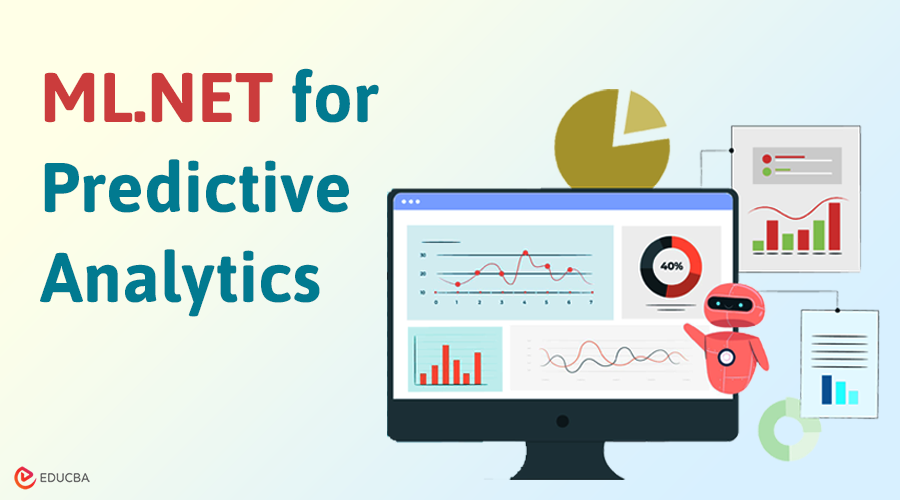
What is ML.NET for Predictive Analytics?
ML.NET is a free tool from Microsoft that lets you create your machine learning models using .NET languages like C#. When we talk about ML.NET for predictive analytics, we refer to its ability to help you analyze data and predict future events or trends based on patterns in that data.
For example, if you have historical data on customer purchases, ML.NET can be used to predict which customers might buy a product in the future or identify trends in buying behaviour.
Connection Between Predictive Analytics and Machine Learning
Predictive analytics and machine learning are closely connected. Predictive analytics relies on machine learning techniques to make future predictions based on historical data.
1. Data-Driven Predictions
Both fields use historical data to predict future events. Predictive analytics traditionally uses statistical methods, while machine learning leverages complex algorithms to find patterns and improve predictions.
2. Advanced Techniques
Machine learning improves predictive analytics by using advanced algorithms that can better manage and analyze large and complex datasets compared to traditional methods. Techniques like neural networks, ensemble methods, and deep learning offer improved accuracy and insights.
3. Model Improvement
In predictive analytics, machine learning models can continuously learn from new data, refining their predictions over time. This iterative process improves the accuracy and relevance of predictions.
4. Automation and Scalability
Machine learning automates the process of model building and updating, making predictive analytics more scalable. This allows organizations to handle larger datasets and more complex predictive tasks without extensive manual intervention.
5. Enhanced Insights
Machine learning can find hidden patterns and connections in data that traditional methods might overlook. This leads to more nuanced and actionable insights.
Steps to Perform a Predictive Analysis with ML.NET Components
To perform ML.NET for predictive analytics, follow these key steps:
Step 1: Setup the Development Environment
- Install .NET SDK and Visual Studio or Visual Studio Code.
- Create a new .NET Core or .NET 5+ project.
Step 2: Add ML.NET NuGet Package
- Use NuGet Package Manager to install the Microsoft.ML package. This package contains the core components for ML.NET.
dotnet add package Microsoft.MLStep 3: Define Data Models
- Create classes to represent the data you will work with. Typically, you need two classes: one for input data and another for prediction results.
public class ModelInput
{
[LoadColumn(0)]
public float Feature1 { get; set; }
[LoadColumn(1)]
public float Feature2 { get; set; }
}
public class ModelOutput
{
[ColumnName(“Prediction”)]
public float Prediction { get; set; }
}Step 4: Load and Prepare Data
- Load your dataset and preprocess it. ML.NET supports various data sources, including text files and databases.
var context = new MLContext();
var data = context.Data.LoadFromTextFile<ModelInput>("data.csv", hasHeader: true, separatorChar: ',');Step 5: Build and Train the Model
- Choose an appropriate algorithm based on your predictive task. For regression tasks, you might use a linear regression model.
var pipeline = context.Transforms.Concatenate("Features", new[] { "Feature1", "Feature2" })
.Append(context.Regression.Trainers.Sdca(labelColumnName: "Label", maximumNumberOfIterations: 100));Step 6: Evaluate the Model
- Assess the performance of your model using metrics such as accuracy, precision, or F1 score for classification and metrics like RMSE (Root Mean Squared Error) for regression.
var model = pipeline.Fit(data);Step 7: Make Predictions
- Apply the trained model to predict outcomes based on new data.
var predictions = model.Transform(data);
var metrics = context.Regression.Evaluate(predictions);
Console.WriteLine($"RMSE: {metrics.RootMeanSquaredError}");
var predictionEngine = context.Model.CreatePredictionEngine<ModelInput, ModelOutput>(model);
var input = new ModelInput { Feature1 = 1.5F, Feature2 = 2.5F };
var result = predictionEngine.Predict(input);
Console.WriteLine($"Prediction: {result.Prediction}");Step 8: Save and Load the Model
- Save your trained model for future use and load it when needed.
context.Model.Save(model, data.Schema, "model.zip");
var loadedModel = context.Model.Load("model.zip", out var schema);Use Cases for ML.NET for Predictive Analytics
1. Sales Forecasting
- Where: Retail and e-commerce businesses.
- Why: To predict future sales based on historical data, seasonal trends, and market conditions. This helps with inventory management and marketing strategy planning.
2. Customer Churn Prediction
- Where: Businesses with subscription models, such as SaaS companies or telecom providers.
- Why: To identify customers who are likely to cancel their subscriptions, allowing companies to engage them with offers to retain them proactively.
3. Fraud Detection
- Where: Financial institutions and online payment systems.
- Why: To identify potentially fraudulent transactions by analyzing patterns and anomalies in transaction data.
4. Recommendation Systems
- Where: Online platforms, such as streaming services or online retailers.
- Why: To recommend products or content based on user preferences and behavior, enhancing user experience and engagement.
Components of ML.NET Predictive Models
ML.NET offers a range of built-in elements, such as data loaders, transformers, instructors, and evaluators.
The most frequently found components are:
- PredictionEngine: Used to make individual predictions with a trained model.
- PredictionEnginePool: Allows a model to make multiple predictions.
- AutoML: Automatically trains and selects the best model for a given dataset.
- TensorFlow Integration: Facilitates using TensorFlow for deep learning tasks, including image and speech recognition.
Final Thoughts
In an era where data is key to innovation, ML.NET for Predictive Analytics empowers businesses to turn raw data into actionable insights. By implementing ML.NET for Predictive Analytics, companies can predict future challenges and identify new opportunities, staying ahead of the competition. The future of business is not just about reacting to change; it is about predicting it, staying innovative, and making smarter decisions.
Recommended Articles
We hope this guide to ML.NET for Predictive Analytics enhances your understanding of machine learning in .NET. Explore these additional articles for more insights into predictive modeling and data analysis.

